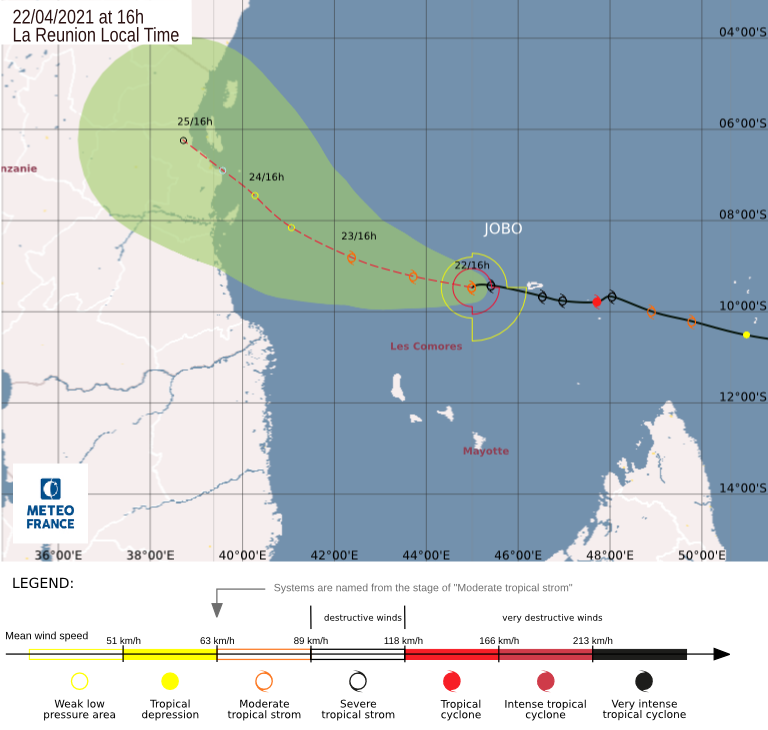By Hellen E. Msemo Declan L. Finney, Cathryn Birch and John Marsham for GCRF-African SWIFT
The current development of the severe tropical storm over the South-Indian Ocean, later classed as severe tropical cyclone Jobo, reminds us of the other rare events where such high-impact storms have made landfall in Tanzania.
In April of 1872 and 1952, two cyclones hit Zanzibar and Lindi respectively (Msemo at all; 2021). The cyclone projection track (Figure 1) suggests there is a possibility of Jobo hitting Tanzanian coastal areas of Tanzania. These areas have had significant increases in population and infrastructure since the Zanzibar and Lindi cyclones.
It is expected that Jobo will have impacts to business and highly populated cities such as Dar es Salaam and Zanzibar. The 2019 Tanzania data from the National Bureau of Statistics shows populations of 5,275,315 and 1,625,589 for Dar Es Salaam and Zanzibar respectively. Other cities with significant population and development includes Lindi, Tanga, Pwani and Mtwara.

The expected trajectory may change due to the impact of the Coriolis force which becomes weak near to the equator, meaning the rotation of winds needed for tropical cyclone formation does not occur. Also, far from the equator, cooler sea surface temperatures inhibit the formation and maintenance of tropical cyclones. As a result, tropical cyclones tend to form between 5 and 15 degrees from the equator (Anthes, R. 2016). However, in the context of climate change, which is associated with rising global temperatures, tropical cyclones may come to form in locations where they are currently unheard of. It is worth noting that cyclones can have devastating impacts if early actions are not taken.
Damage could exceed previous cyclones in Tanzania
Tanzania could face severe devastating impacts due to the Jobo cyclone, greater than those felt during the 1872 and 1952 tropical cyclones (Figure 2). There is higher pollution in the cities along the coastal areas, significant development in infrastructure and business activities, all which may increase the vulnerability and the severity of the impacts associated with severe weather. Also, due to the higher vulnerability and exposure of the coastal regions to storm surges, flooding, and risk to coastal livelihoods, the impacts of Jobo could be very high.
Warning authorities, Disaster Management Authority, civil society organizations and the community need to be ready and take early actions to reduce the impacts if the cyclone makes landfall as expected. The eye-witness accounts and meteorological observations documented during the 1872 and 1972 events and recent publications provide evidence of occurrences of these rare events and their devastating impacts to socio-economic activities (Msemo at all; 2021).

The Lindi tropical cyclone resulted in extensive damage which was estimated at £2.5 million (equivalent to £72 million in 2020), while the Zanzibar cyclone impacted the substantial properties owned by the Sultan, Arabs and Indian boats (Msemo at all; 2021, Lindström, 2019). The Roman Catholic Mission Hospital at Bagamoyo was also destroyed, along with two thirds of the clove and coconut plantations on Zanzibar (Msemo at all, 2021; UNDRR, 2019). The cyclone destroyed over 50 houses and agricultural schemes of the Catholic Father over Bagomoyo city (Lindström, 2019).
With advancement in forecasting techniques, meteorologists are able to track and model the path of cyclones and can provide impact-based forecasts of cyclones. This information can inform and protect people from the expected impacts of extreme weather events. Awareness to the community living along the coast and decision-makers dealing with disaster risk management is important.
Paper information
Msemo, H. E., Finney, D. L. & Mbuya, S. I. (2021). Forgotten accounts of tropical cyclones making landfall in Tanzania. Weather. https://doi.org/10.1002/wea.3921
References
Anthes, R. ed., (2016). Tropical cyclones: their evolution, structure and effects (Vol. 19). Springer.48-5
Lindström J. 2019. Muted memories: Heritage-making, Bagamoyo, and the East African caravan trade. New York/Oxford: Berghahn Books
UNDRR. 2019. Country profile. https://www.desinventar.net/DesInventar/results.jsp?bookmark=1&countrycode=tza&maxhits=100&lang=EN&logic=AND&sortby=0&frompage=/results.jsp&viewStandard=Y [Accessed 19 December 2019]
